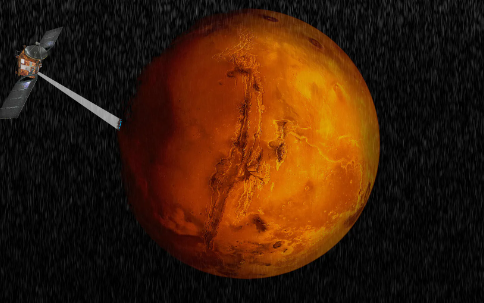Liquid Water Found Deep in Mars’ Crust, Study Reveals
Recent research has revealed large amounts of liquid water hidden beneath the surface of Mars. This discovery challenges what scientists previously thought about water on Mars and opens up new possibilities for understanding the planet’s geology and the potential for life.
Overview of the Study
The study, titled Liquid water in the Martian mid-crust, was published in the journal Proceedings of the National Academy of Sciences (PNAS). It was conducted by a team from the University of California San Diego, led by scientists Vashan Wright, Matthias Morzfeld, and Michael Manga.
How the Research Was Done
Researchers used data from NASA’s Mars Insight Lander, which was active from 2018 to 2022. The lander had a special instrument called a seismometer that recorded vibrations or “quakes” on Mars, called Marsquakes. It detected over 1,300 Marsquakes and impacts from things like meteorites. By studying how fast seismic waves moved through the ground, the team could figure out what kinds of materials the waves were passing through. They found signs of a layer of cracked igneous rock (a type of volcanic rock) filled with liquid water, located about 10 to 20 kilometers (6 to 12 miles) below the surface.
Important Discoveries
The study suggests that this liquid water might have come from rivers and lakes that existed billions of years ago on Mars. If this water is spread throughout the planet, it could make up a large underground ocean. This finding has big implications for understanding how water cycles and climate on Mars have changed over time.
What This Means for Life on Mars
While this discovery doesn’t prove that life exists on Mars, it increases the chances that the planet could support life. Water is a key ingredient for life, and underground water could sustain simple life forms, similar to how life exists deep underground or at the bottom of the ocean on Earth. Even though finding water on Mars is exciting, getting to it would be extremely difficult. Drilling 10 to 20 kilometers (6 to 12 miles) into Mars’ surface would be a huge challenge, especially if humans want to live on Mars or use this water. This makes plans to colonize Mars or use its resources much more complicated.
Facts About Mars
- Mars is often called the Red Planet.
- Mars has the largest volcano in the solar system, called Olympus Mons, which is about 13.6 miles high.
- A day on Mars, known as a sol, lasts about 24.3 hours.
- Mars has two small moons, Phobos and Deimos, which are likely captured asteroids.
- Water ice is found at Mars’ poles, and there’s recent evidence that salty water might flow during certain seasons.
- The atmosphere of Mars is 95% carbon dioxide.
- Mars has the biggest dust storms in the solar system, which can cover large areas.
Month: Current Affairs - August, 2024
Category: Science & Technology Current Affairs








